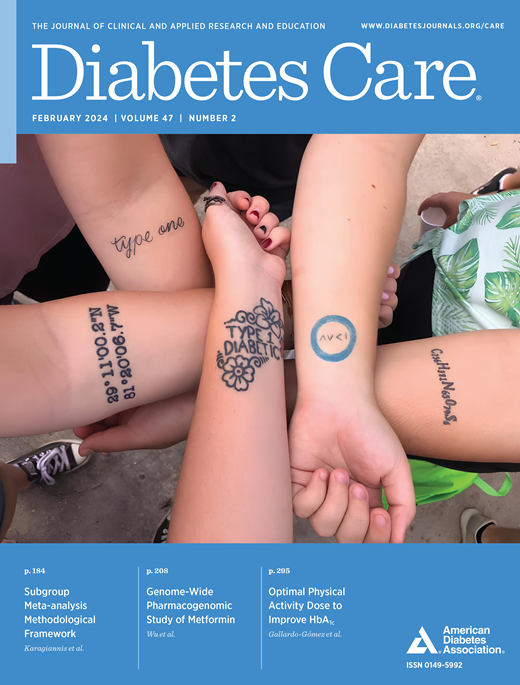支持新兴成人糖尿病患者 (SEAD) 计划:以成人为基础的真实世界临床模式,可改善未接受治疗的 1 型糖尿病年轻成人的住院率、糖尿病技术接受率和血糖结果
IF 14.8
1区 医学
Q1 ENDOCRINOLOGY & METABOLISM
引用次数: 0
摘要
目标 未得到充分服务的 1 型糖尿病(T1D)年轻成人(YA)患者在整个生命周期中的预后最差。我们开发了 "支持新发成人糖尿病患者(SEAD)"项目,并将其纳入常规内分泌护理中,以应对尚未解决的社会和医疗挑战。研究设计与方法 本研究设计为纵向队列研究,在 4 年时间里收集了有关 SEAD 与常规内分泌护理相比的 YA 的前瞻性数据。我们使用倾向加权分析来考虑基线特征的差异,并使用多变量回归和 Cox 比例危险模型来评估随时间推移的结果变化。主要结果包括住院率、糖尿病技术接受率和 HbA1c 水平的年度变化。结果 我们纳入了497名患有T1D的青少年,他们分别接受了SEAD(n = 332)和常规内分泌治疗(n = 165);平均年龄25岁,27%为非西班牙裔黑人,46%为西班牙裔,49%为公共保险,平均HbA1c为9.2%。比较 SEAD 中的亚健康与常规护理,1)基线 HbA1c >9% 的住院发生率降低了 64% (HR 0.36 [0.13, 0.98]),公共保险的住院发生率降低了 74% (HR 0.26 [0.07, 0.90]);2)胰岛素自动给药率高出 1.5 倍(HR 1.51 [0.83, 2.77]);3)HbA1c 改善幅度更大(SEAD,每年-0.37% [-0.59, -0.15];常规护理,每年-0.26% [-0.58, 0.05])。结论 SEAD 能有效改善服务不足的 T1D 青少年的临床治疗效果,尤其是对于已参加公共保险且 HbA1c 基线水平较高的青少年。在患有 T1D 的高危青少年进入成人护理阶段时对他们进行早期干预,可以减少短期和长期结果的不平等。本文章由计算机程序翻译,如有差异,请以英文原文为准。
The Supporting Emerging Adults With Diabetes (SEAD) Program: An Adult-Based Real-World Clinical Model That Improves Hospitalizations, Diabetes Technology Uptake, and Glycemic Outcomes in Underserved Young Adults With Type 1 Diabetes
OBJECTIVE Underserved young adults (YA) with type 1 diabetes (T1D) experience the worst outcomes across the life span. We developed and integrated the Supporting Emerging Adults with Diabetes (SEAD) program into routine endocrinology care to address unmet social and medical challenges. RESEARCH DESIGN AND METHODS This study was designed as a longitudinal cohort study, with prospective data collection over 4 years on YA in SEAD compared with usual endocrine care. We used propensity-weighted analysis to account for differences in baseline characteristics, and multivariate regression and Cox proportional hazard models to evaluate change in outcomes over time. Primary outcomes included incidence of hospitalizations, diabetes technology uptake, and annual change in HbA1c levels. RESULTS We included 497 YA with T1D in SEAD (n = 332) and usual endocrine care (n = 165); mean age 25 years, 27% non-Hispanic Black, 46% Hispanic, 49% public insurance, mean HbA1c 9.2%. Comparing YA in SEAD versus usual care, 1) incidence of hospitalizations was reduced by 64% for baseline HbA1c >9% (HR 0.36 [0.13, 0.98]) and 74% for publicly insured (HR 0.26 [0.07, 0.90]); 2) automated insulin delivery uptake was 1.5-times higher (HR 1.51 [0.83, 2.77]); and 3) HbA1c improvement was greater (SEAD, −0.37% per year [−0.59, −0.15]; usual care, −0.26% per year [−0.58, 0.05]). CONCLUSIONS SEAD meaningfully improves clinical outcomes in underserved YA with T1D, especially for publicly insured and high baseline HbA1c levels. Early intervention for at-risk YA with T1D as they enter adult care could reduce inequity in short and long-term outcomes.
求助全文
通过发布文献求助,成功后即可免费获取论文全文。
去求助
来源期刊

Diabetes Care
医学-内分泌学与代谢
CiteScore
27.80
自引率
4.90%
发文量
449
审稿时长
1 months
期刊介绍:
The journal's overarching mission can be captured by the simple word "Care," reflecting its commitment to enhancing patient well-being. Diabetes Care aims to support better patient care by addressing the comprehensive needs of healthcare professionals dedicated to managing diabetes.
Diabetes Care serves as a valuable resource for healthcare practitioners, aiming to advance knowledge, foster research, and improve diabetes management. The journal publishes original research across various categories, including Clinical Care, Education, Nutrition, Psychosocial Research, Epidemiology, Health Services Research, Emerging Treatments and Technologies, Pathophysiology, Complications, and Cardiovascular and Metabolic Risk. Additionally, Diabetes Care features ADA statements, consensus reports, review articles, letters to the editor, and health/medical news, appealing to a diverse audience of physicians, researchers, psychologists, educators, and other healthcare professionals.
 求助内容:
求助内容: 应助结果提醒方式:
应助结果提醒方式:


